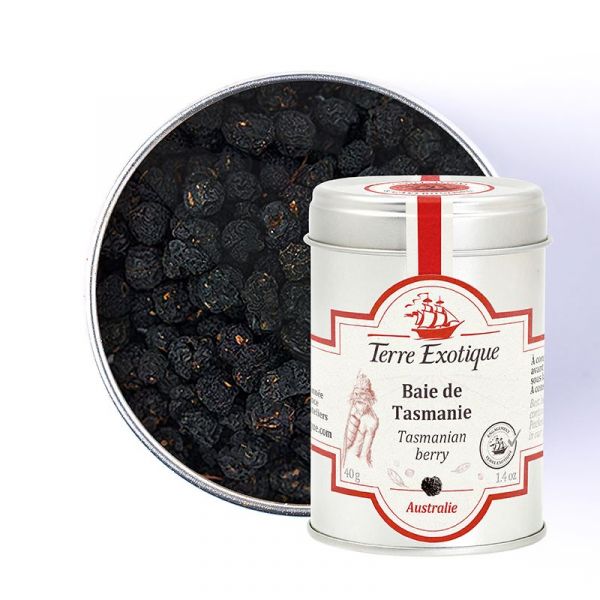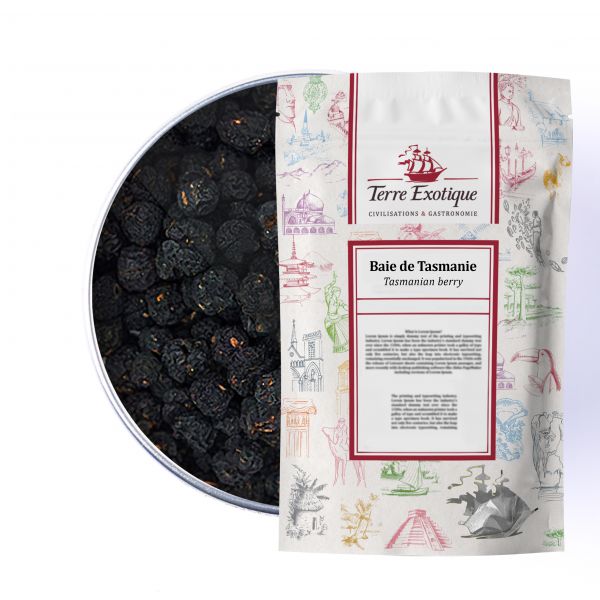







In which dishes to use Tasmanian berry?
Explore the fruity flavors of Tasmanian berry
Tasmanian berry is a classic with fish. Indeed, this wild berry pairs perfectly with seafood! It colors food with a pretty purple more or less supported depending on the dose and cooking method.
How to use Tasmanian berry?
Our recipe ideas to use Tasmanian berry in your cooking:
· Tasmanian berry chocolate mousse: crush 4 Tasmanian berries and add them to your melted chocolate;
· Tasmanian berry mayonnaise: crush 5 Tasmanian berries and put them in your mayonnaise before mounting it;
· leg of lamb: add 2 teaspoons of ground Tasmanian berry to your marinade then spread it all over your leg of lamb;
· Tasmanian berry shrimp: crush 4 Tasmanian berries and add them to your shrimp with the marinade;
· apple and Tasmanian berry pie: marinate your apples with 5 crushed Tasmanian berries;
· Tasmanian berry salmon: sprinkle ½ teaspoon of crushed Tasmanian berries on your salmon fillets;
· Tasmanian berry ice cream: infuse 3g of ground Tasmanian berries into your preparation composed of 375ml of milk, 225ml of cream, 225g of sugar, and 6 egg yolks.
The aromas of Tasmanian berry
This indigenous pepper has a laurel and hemp scent with floral notes that tend towards geranium. In the mouth, it is intensely spicy, with a sweet-bitter taste with aromatic accents of undergrowth, red fruits, and juniper. It should be noted that Tasmanian berry can cause a numbing sensation just like Szechuan berry, so care should be taken with the dosage.
Tasmanian berry, wild and rare
How does Tasmanian berry grow?
This berry grows wild in the rainforests of northeastern and northwestern Tasmania. The main collection area is in the hills of "Surrey Hills", near the now-extinct town of Parrawe. The berries are handpicked from March to April and then air-dried. Only 5 tons of Tasmanian berries are harvested each year. Tasmanian berry, widely used by Aboriginal peoples, is now essential in Australian local cuisine "bushtucker": a set of wild animal and plant species from Australia. Moreover, the term "bushtucker" also refers to the privileged status enjoyed by the man of the Aboriginal tribe who is responsible for hunting and gathering.
This pepper has no relation to Piper nigrum pepper; it belongs to the botanical family Winteraceae. Like its cousin Chiloé pepper, the Tasmanian berry plant follows a three-year life cycle with a bountiful harvest followed by a medium harvest and a very low harvest.
It is a rare gem, found only in Australia, in the regions of Victoria and New South Wales, as well as of course in Tasmania. This purple berry is the fruit of Tasmannia lanceolata, an evergreen shrub 2 m high, with plum branches and very beautiful pale green foliage. When drying, it turns black but colors food purple when cooked.
The history of Tasmanian berry
Discovered by the French botanist Jean-Louis Marie Poiret, Tasmanian berry was used in cooking by indigenous peoples. Renowned for its aphrodisiac and antimicrobial properties, this wild berry was widely used in traditional medicine. In cooking, it was mainly used to marinate meats such as ostrich, emu, crocodile, or kangaroo.
In the early nineteenth century, plants were brought to Cornwall, UK. Brought back into the spotlight in the last ten years, Tasmanian berry is unanimous among Australian and New Zealand chefs who compete in originality to use it in cooking: Tasmanian berry ice creams, chimichurri sauce for barbecues, roasted crayfish... Try it out, you'll adopt it!
Advice on using Tasmanian berry
- To crush in a mortar at the last moment: the aromas of Tasmanian berry are volatile.
- To use sparingly: the power of the spiciness is released gradually.
| Allergen | Absence |
|---|---|
| Native country | AUSTRALIE |
| Genus and botanical species | Tasmannia lanceolata |
| Ingredients | Tasmanian berry |
| TRACES EVENTUELLES D'ALLERGÈNES | céleri, sésame, moutarde, fruits à coques. |
 Français
Français 